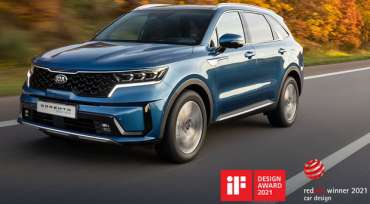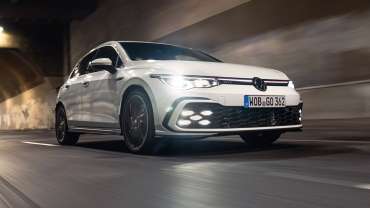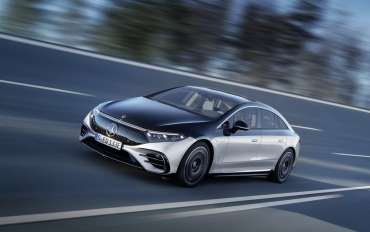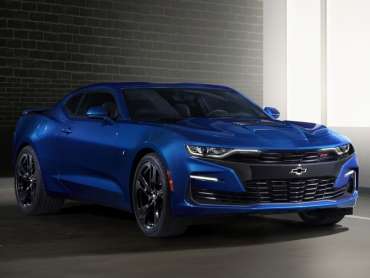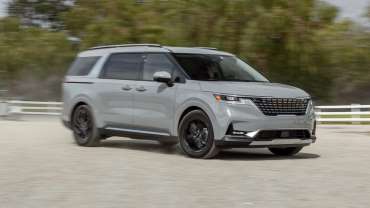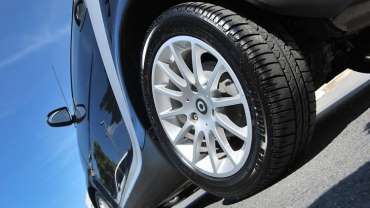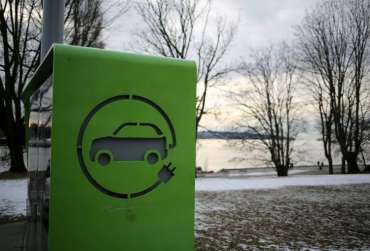
Worldcarblog.com
Kia Sorento winner of Red Dot and iF design awards
Kia’s prestigious SUV, the multi-award winning Sorento, won two new globally recognized laurels - the Red Dot and iF model design awards.
Since 2009, Kia has won 47 Red Dot and iF design awards
With the latest Red Dot and IF awards, the design-driven Kia brand continues its remarkable string of successes in these two competitions. Since 2009, when the Kia Soul became the first Korean model to win Red Dot, 26 Kia models have won this award. As for the iF award, which Kia won for the first time in 2010, the number of awarded Kia models, including the new Sorrento, climbed to as much as 21.
Shortly after last year’s premiere, the Sorento received recognition for outstanding off-road vehicle design in 2020 from Auto Bild Allrad magazine. After that, he won the most significant German car award, the Golden Steering Wheel 2020, in the segment of large sports SUVs. In March this year, it became the Women's World Car of 2021 in the category of large sports SUVs.
The new generation of sports SUV was created in cooperation with Kia's world design network. Karim Habib, head of Kia's global design center, said: "In designing the new Sorrento, we wanted to first develop the robust aesthetics of previous generations of models, while using a greater dose of sophistication and elegance. is a mature and balanced but confident design. We are delighted that prestigious institutions, which share design awards, such as Red Dot and iF, have recognized our work. "
Red Dot and iF: two globally most important design awards
The Red Dot and iF design awards are among the largest and most significant design competitions in the world. The Red Dot Award is awarded each year at the North Rhine-Westphalia design center and is divided into three disciplines: product design, brand and communication design, and concept design. The Red Dot Awards for product design have been awarded since 1955, and this year's competition was attended by manufacturers and designers from 60 countries, who submitted 7,800 products. The submitted products were evaluated by an international jury, which consisted of about 50 independent designers, design professors and journalists from various sectors. In addition to aesthetics, products are evaluated on the basis of criteria such as the degree of innovation, functionality, ergonomics, quality and environmental friendliness.
The iF Design Award, organized by the International Forum Design GmbH of Hanover, has existed since 1954 and is one of the leading independent design institutions in the world. This year, competitors from 52 countries registered more than 9,500 products, and the competition itself experienced several novelties. These are e.g. digital preliminary phase ('Online Preselection') in which half of the submitted works entered the finals ('Final Jury'), transparent evaluation was performed in all categories, including the new categories 'user experience' (UX) and 'user interface' ( UU). Other categories are products, communications, packaging and service design, architecture, interior design and professional concepts. This year, the iF jury was composed of 98 independent international design experts. All award-winning products are published in the "iF World Design Guide" catalog (ifworlddesignguide.com) and in the "iF Design App".
2022 Volkswagen GTI First Test: They Still Make ’Em Like They Used To
New tech doesn’t dull the VW GTI’s legendary character.
Can a car have a panic attack? No? Okay, good. For a second there, we wanted to throw a weighted car cover over our white 2022 Volkswagen GTI and slip some sort of vehicular benzodiazepine in its gas tank. If it could gain sentience, this shapely little hatch might incessantly blare its horn and idle at 4,000 rpm out of pure existential angst.
Could you blame the poor thing? First and foremost, it's a new gas-powered compact hatch from an automaker that has made it very clear that its future is both electric and filled mostly with SUVs. It killed the regular Golf hatch in the States, leaving the new MkVIII GTI and forthcoming Golf R as the only America-bound fruit from that once bountiful branch. As part of this Golf goodbye, our GTIs will come from Germany, not Mexico, and won't arrive here until late this year.
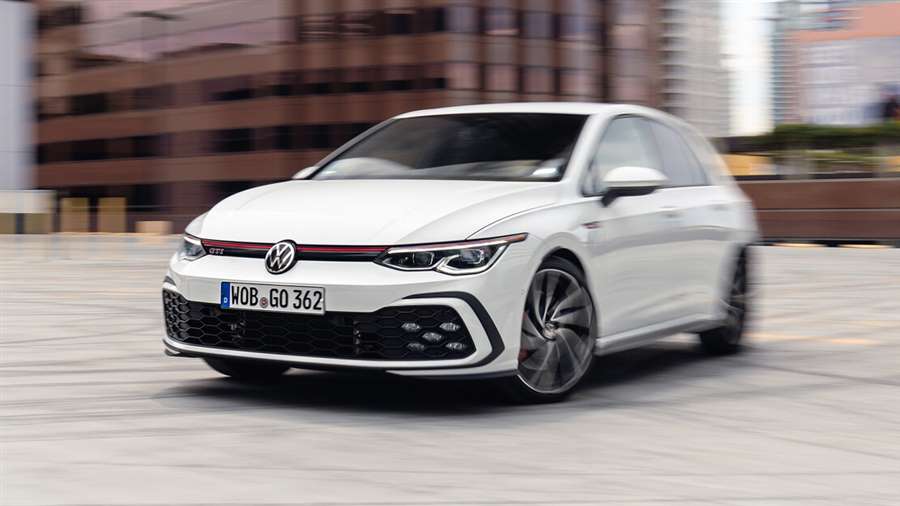
It's enough to make anyone a bit nuts. Though, from behind the wheel of the latest and greatest iteration of the perennial hot hatch gold standard, we might be a bit off with our silly anthropomorphism of the MkVIII. Scooting around traffic-clogged city streets, cramming gear into the cargo area, stuffing friends in the back seat, squeezing into tight parking spaces—it's all handled with the familiar chilled-out, cooler-than-you German modernism that makes the Golf—oops, Freudian slip—GTI such a fan favorite.
Oh, and it's also a hoot and a half to drive, but we'll get to that in a bit. The circumstance surrounding our first scoop of the MkVIII is a bit of a whirlwind; we'd not yet gotten so much as a physical walkaround of the new GTI before it buzzed to our test track to be put through our data-driven trials. So, consider this our first touch, first sniff, first drive, first test—first everything.
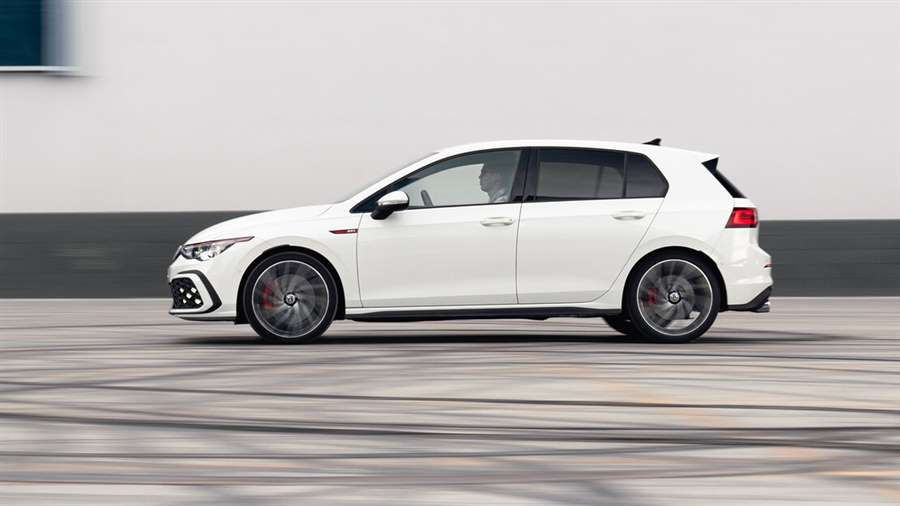
Same As It Ever Was? Hardly.
Still, in a way, this is a meeting of old friends. Underneath those fresh, ID3-esque exterior duds lie the augmented bones of the existing MkVII GTI. VeeDub's rather excellent and wide-ranging MQB platform is still here, so that means if you like how the MkVII GTI rides and drives—boy, you're going to love this.
The 2022 GTI is significantly spruced-up over the existing car. The MacPherson-strut front suspension's wishbone bushings, bump stops, and springs are revised and tweaked, along with the software associated with the optional adjustable dampers. All this is carried by an aluminum subframe that shaves 6.6 pounds over the old setup. It was purloined from the prior GTI Clubsport S, a scorching hot hatch that was briefly the FWD record-holder around the 'Ring.
Around back, the multilink rear suspension is refreshed, too. More software updates and reworked springs, helper springs, wheel mounts, damper bearings, and wishbone bushings keep it all in line. A note on those aforementioned spring rates; they're five percent stiffer in the front and 15 percent stiffer in the rear.
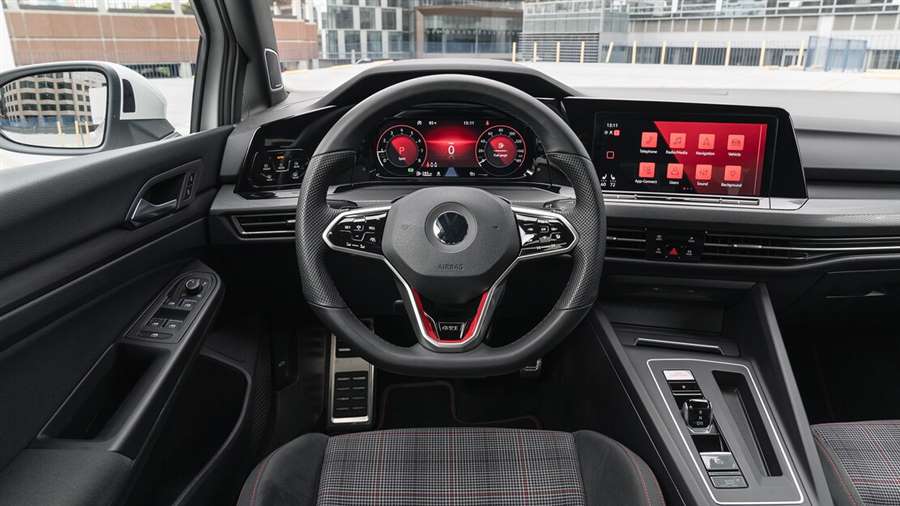
Elsewhere, the software for the electric-assisted steering has been re-coded for sharper turn-in when you want it and lighter effort when you don't. A new brake master cylinder modulates pressure based on driving style and environment: softer and more progressive around town in Comfort mode and a stiff, early bite when you're caning it.
Power, And Lots Of It
Power still comes from the EA888 2.0-liter turbocharged inline-4, but that is the last thing we'd want changed from the MkVII GTI. The Volkswagen Group's ubiquitous turbo-four has, for some of us, become the definitive engine that springs to mind when the subject turns to 2.0Ts. Power is a stout 242 horsepower and 273 lb-ft of torque, routed solely to the front wheels—as the GTI gods intended—through either a six-speed manual or a seven-speed dual-clutch DSG transmission, as in our test car. Crucially, a limited-slip diff is standard, so all MkVIII GTIs should fundamentally be created equal on the performance front.
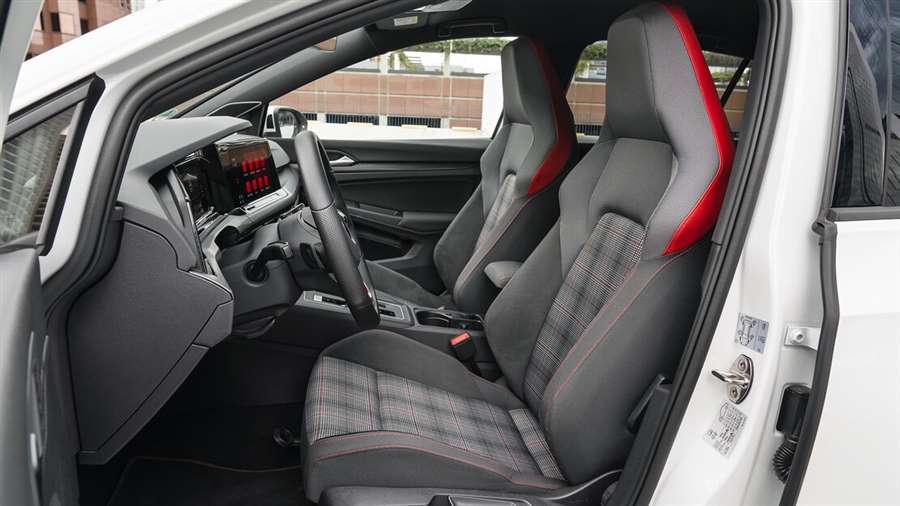
VW says all this adds up to a 0-60-mph run in 6.3 seconds, but we say VW's been taking pages from Porsche's playbook on purposeful underrating. On our strip, associate road test editor Erick Ayapana ran this automatic-transmission front-driver to a very impressive 5.4-second 0-60 time on its way to a 13.9-second quarter-mile, beating out a DSG-equipped MkVII by 0.6 second in both metrics.
The GTI's software didn't make it easy, though. Ayapana had to work around the big torque and tricky transmission tuning in the pursuit of a clean launch. "It's got sloppy launch control," he said. "It holds the engine revs super high and then rides the clutch for what seems like eternity, and after all that, it still couldn't manage wheelspin."
Heroic Handling Habits
Over on the figure-eight and skidpad, the GTI continued its boot-scootin'. It dispatched the ever-tricky figure-eight in 25.0 seconds at an average of 0.74 g, improving on the MkVII GTI with DSG by 1.1 second and 0.05 g. The new GTI hustled around the skidpad at a sweet 0.96 g average, topping its predecessor by a not-insubstantial 0.05 g. This is still notably behind the 24.1-second, 0.81-g average figure-eight time of the latest Honda Civic Type R, but that's fine; the Type R squares off against VW's own Golf R that's coming sometime later this year or early next year.
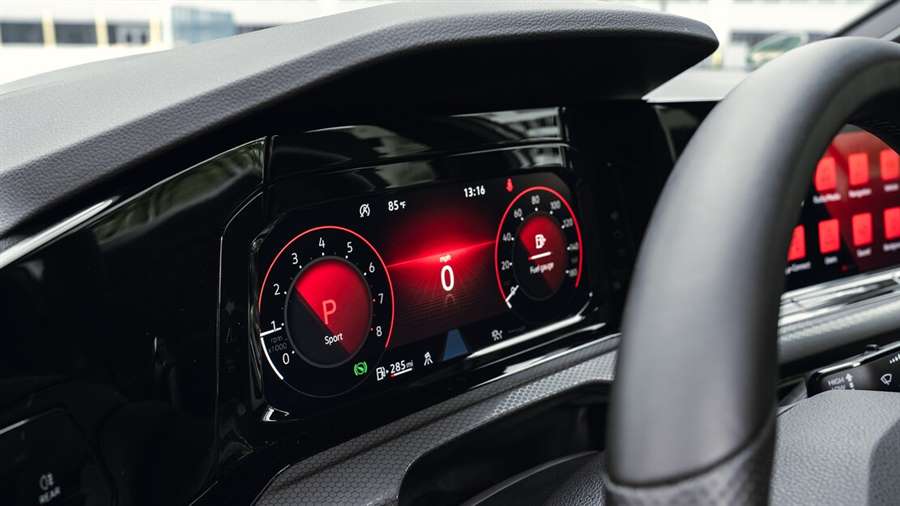
Back on the GTI, road test editor and handling head honcho Chris Walton was duly impressed. "Wow, Volkswagen has really stepped up its game," he said. "The steering is very good; it doesn't feel artificially heavy or light. Just right. I wasn't expecting the GTI to be this capable and fun." Still, like Ayapana, he noted the DSG as having sometimes smart, sometimes baffling programming. Both agreed on the GTI's excellent brakes, which returned a best 60-0-mph stopping distance of 104 feet. "Very confident and talkative brakes," Walton said. "Short travel and you can trail them deep into the skidpad."
Less Track, More Road
The track results are good, but how the new GTI fares on the road—both straight and curvy—is of far greater import. With keys in hand, we couldn't help ourselves—we went straight to the canyons. First impression is that of blissful neutrality; that standard LSD and extensive front-end fettling purged most of the nasty understeer that in the MkVII was always present on the fringes of a too-hot corner entry. Barrel into a corner in the new GTI, and you'll get some tug and scramble from the front end as all the systems frantically but effectively rein in your silliness and shoot you out the other side with nary a scratch.
As it has been for decades, the GTI's is an elemental driving experience, much like a Mazda Miata, Ford Mustang, or Porsche 911. This VW leans into the front-wheel-drive layout, with the most effective method of quick cornering being to feed in throttle just as you approach the apex and allow the front tires and LSD to pull you through like a slingshot. Suspension tuning is predictable and, in the stiffer Sport setting, requisitely flat and composed even during moments of aggressive weight transfer.
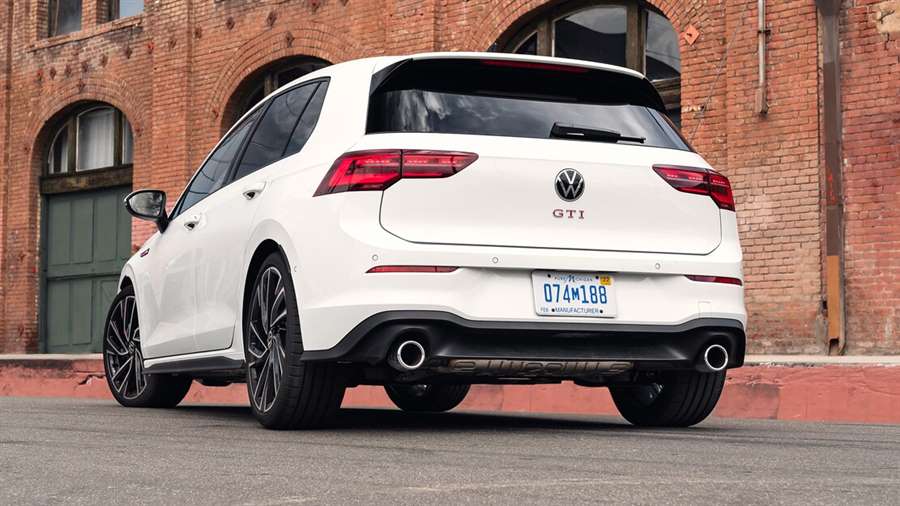
Beautiful Brake Balance
The steering is on the artificial end of the spectrum, but it loads up nicely and is sweetly accurate in the heavier Sport mode. The test team wasn't kidding about the brakes; they're no carbon-ceramic stompers, but these are some of the most confident hot hatch brakes we've experienced in some time. On much of our road drive, we left both the stability and traction control on, fully expecting the brake-actuated systems to sap brake efficacy after a few blasts through our test loop.
Not so. Through a combination of well-tuned TC/ESC and that new variable brake master cylinder, we had to drive absurdly fast on seriously tight roads before the brakes conveyed any sense of softness or fade. Even after extended bouts of hooliganism, the brakes continued to stop strong and true at every corner.
Two-Faced In The Best Way
Power is plentiful, but in torque we trust. Merging and hard pulls down straights were pure fun, with plenty of initial telltale rumble and wheel hop shake up front as the chassis struggled to manage all 273 lb-ft. When it hooks up, you're off, reaching speed and acceleration far beyond the expectations levied by the "GTI" badge on the rear liftgate.
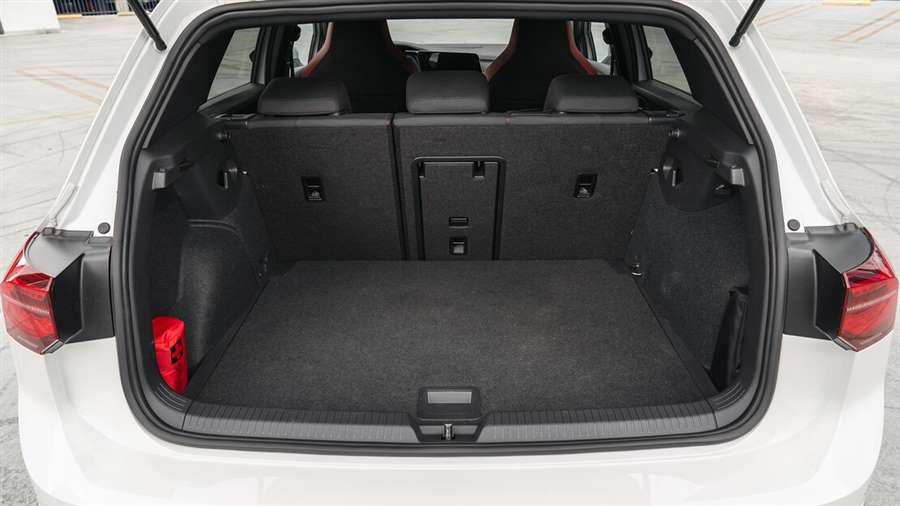
Time to settle down and go home. Back in Comfort mode, everything relaxes and decompresses, transforming a riotous sport compact into a regular hatchback with a vaguely firm suspension. On the oft-broken pavement that snakes through Los Angeles, every bump, crag, and expansion joint was both physically and acoustically well isolated, especially when you futz with the Dynamic Chassis Control's (DCC) 15-position slider to dial in your preferred level of aggression.
Who Asked For This?
Now we get to our singular glaring issue with the all-new VW GTI. It seems VW is keen on superimposing the all-electric ID4's interior tech onto its other new products, meaning the GTI's interior is almost entirely devoid of physical buttons. Instead, touch-capacitive panels adorn the dash and steering wheel, operating just about every function available. The headlights, climate control, drive modes, volume, tuning, cruise control, and cluster menu selection are all operated via these single-piece, backlit gloss plastic panels.
What's not touch capacitive is squirreled away in the sharp and pretty touchscreen infotainment system, but some items seem almost purposefully obfuscated. The traction control, for instance, is buried behind the vehicle settings menu under the "brakes" subsection. It's all very cutting edge and futuristic, but it feels very much like the solution to a problem that didn't exist. We got used to the touch controls within a few hours of seat time, but they never became second nature. What's more, most of the once-glossy surfaces became a modern art installation of greasy fingerprints and nasty smudges. Buttons, please.
Pricing—What We (Don't) Know
What we cannot report on is just how well equipped (or not) the new GTI will be when it hits dealers, as our example was a German-market car, skinny Euro registration plate and all, and the equipment levels could notably differ. Heck, we don't even have a clear idea of pricing, but figure it land somewhere around $31,000. For now, if you want to grab one of these, we think the wait will be well worth it. As the U.S.—and Volkswagen—increasingly cuts ties with internal combustion, it's nice to know joyful cars like the 2022 Volkswagen GTI will be with us until the final switch is flipped.
World premiere: The Mercedes EQS is something completely different
The world premiere of the new flagship of the Mercedes-Benz brand was held on April 15. In the years ahead, the EQS model will have the significance that the S-Class had in the years behind us.
It may be able to connect with important Mercedes only because it is luxurious, but the new top limousine from Stuttgart is different in everything else. The unexpected design, called the "one bow roofline", has made the EQS the most aerodynamic production car in the world.
There is also a giant hyper-screen in the cabin of 141 cm and a range of 700 km on electricity (and the same amount of horsepower in the strongest version). These are just some of the trump cards, in fact, not trump cards, but tasks for others, because we know that, whether people like it or not, history records that Mercedes regularly sets standards. Meet the EQS - the electric sedan of the future, in the present.
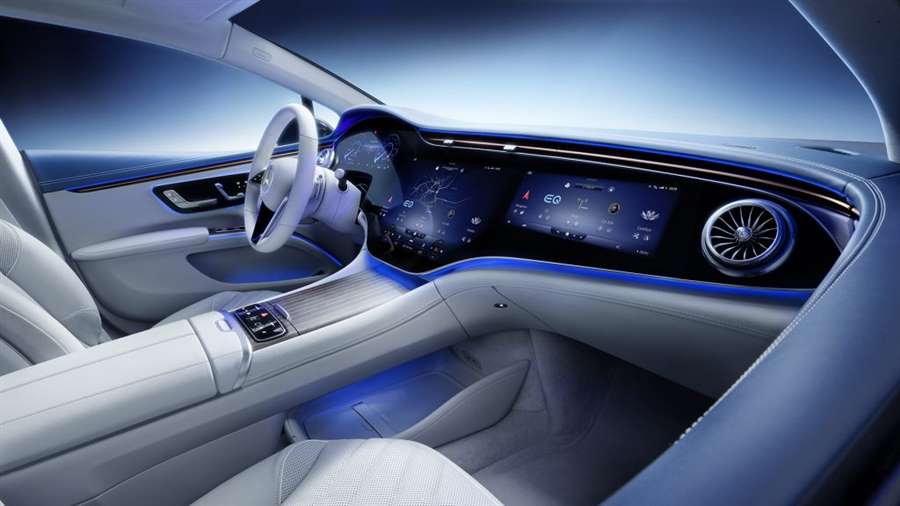
The design of the arch-like sedan, which may not appeal to everyone, has contributed to the 0.20 cd EQS being, as we said, the most aerodynamic production electric sedan (better than both the Tesla S and the Lucid Air model). It's even a kind of legacy from Mercedes - some of the most cult models from the past could also boast that the gusts of wind can be their allies. We are thinking of one of the models that always evokes fond memories, and it was also the first compact sedan with a star on the hood - the legendary 190.
So, design. Yes, it is unusual. Some are already saying that the profile is "critical", while the EQS from the front and back is great. But it's still too fresh to comment. The design should be given time to settle, which has been confirmed many times throughout history. What we can say is that we liked the electric rival from Audi - the e-tron GT, at first glance. But we whispered that to you. We said we wouldn’t talk about design, much less about tastes.
EQS is the so-called "Liftback" sedan which, as they say from Mercedes, should cost something similar to the new S-Class. We'll see.
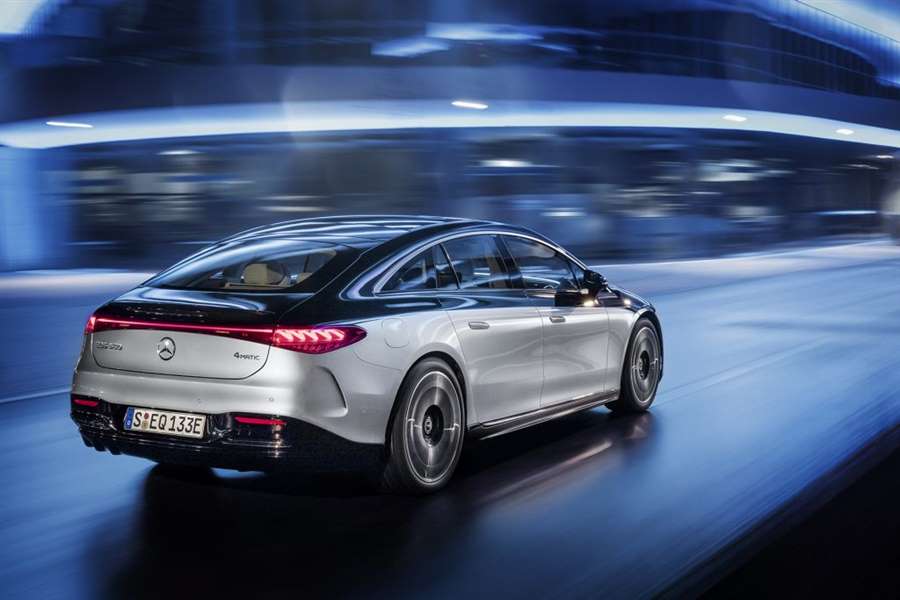
This sedan is also the first Mercedes to be built from scratch as an electric vehicle. It was created on the EVA platform on which EQE (E-Class on electricity), then EQE SUV, as well as EQS SUV will be based.
This base, among other things, allows them special air suspension and control of the rear wheels. Thus, the EQS is 5.2 meters long, 1.9 m wide and 1.5 m high, in addition to being aerodynamic, it also boasts a turning diameter of only 10.9 meters.
The distance between the axles is 3.2 meters (106 cm more than the S-Class), which means that two-meter walkers will be able to stretch their legs inside without any trouble. The lucky ones. And they will also enjoy the "No.6 Mood Linen" fragrance designed especially for EQS. It is number 6 because the first electric cars were added to the 1906 model range with "Mercédès Electrique" vehicles.
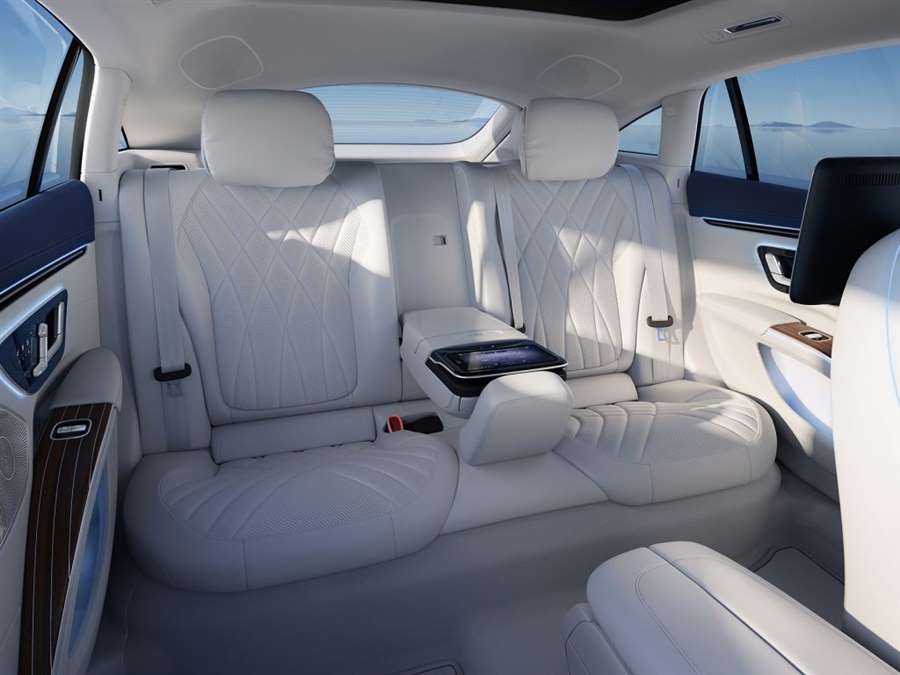
Who cares, the trunk is 610 / 1,770 liters (60 liters more than the S-Class).
Design. Again. It is important to say that the EQS is also made of a lot of aluminum, and in front of the mask there is a black panel that connects the headlights connected by a light strip that extends the entire width of the front part. Now watch this - Digital Light has a light module with three extremely powerful LEDs with light that is refracted and directed by 1.3 million micro mirrors. The resolution is, therefore, greater than 2.6 million pixels per vehicle. That's what they say in Mercedes.
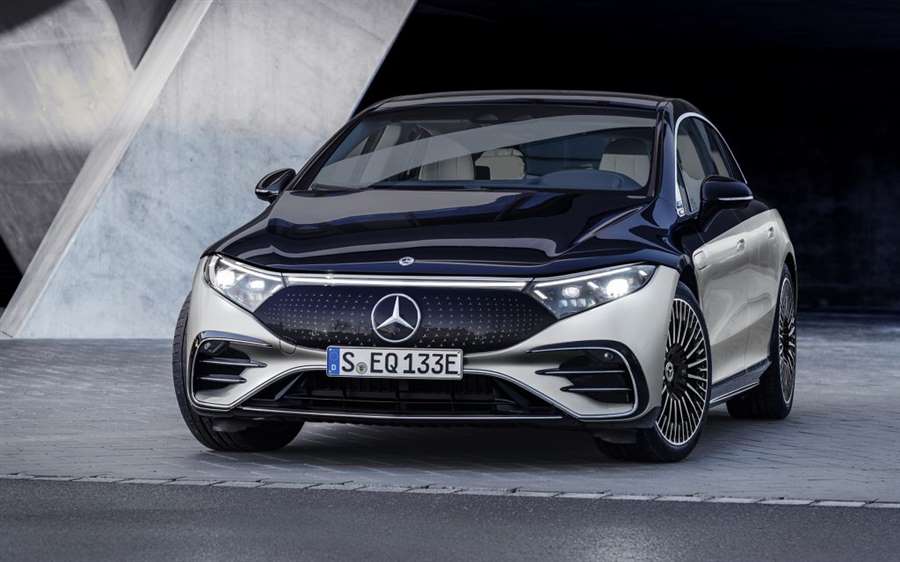
What's inside
We have already written about the cabin, because it was shown before the premiere (find out more here), so we will now present some very interesting figures and information about the hyper-madness inside. With the MBUX Hyperscreen, several screens seem to blend seamlessly, resulting in an impressive curved screen width of 141 centimeters.
The large glass covered by the Hyperscreen is three-dimensionally curved in the molding process at temperatures of approximately 650 ° C. This manufacturing process allows the display to be displayed without distortion across the entire width of the vehicle.
To get to the most important MBUX applications, the user navigates through 0 menu levels. Everything is there right away. That is why it is called "zero layer". Also, through this system, the driver has the option of remotely opening the rear door.
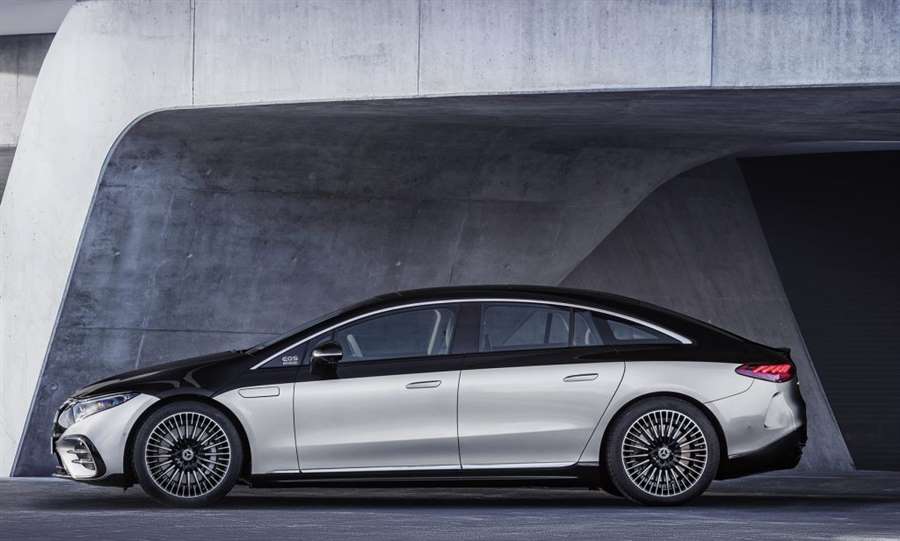
The display area of the optional larger head-up display corresponds to a 77-inch screen. The projection unit consists of a high-resolution matrix of 1.3 million individual mirrors. And they say that in a Mercedes.
For haptic feedback during operation, a total of 12 actuators are located below the surfaces of the Hyperscreen. If the finger touches certain places, they trigger vibrations. The coating on the glass makes cleaning easier, and only the curved glass consists of scratch-resistant aluminum silicate.
Two versions of EQS
The rear axle of the EQS 450 has an electric motor that delivers 333 hp and 568 Nm, while the more powerful EQS 580 has two electric motors (on each axle), thus offering e-4 × 4 drive and a total power of 523 hp and 885 Nm.
It reaches the "hundredth" EQS, weighing 2.5 tons, in 4.3 seconds, or 6.2 in the weaker version. Top speed is 210 km / h. Both versions use a powerful 107.8 kWh battery that can provide a range of 700 km.
An AMG variant is planned to be based on the EQS 580 iwill have more than 700 hp.
Otherwise, depending on the equipment, up to 350 sensors monitor the functions of the EQS and explore the vehicle's environment. And we don't count antennas in that number. The sensors measure, for example, distance, speed and acceleration, lighting conditions, precipitation and temperature, seat occupancy, and count and monitor the movement of the driver's hood or passenger speech.
So much for advanced technology for today.
You’ll never guess what the Chevrolet Camaro is having trouble with
No… It's not a click-bait title, but this short story is so shifted at its core that it was not clear to me who was still in "Aprilililili mode".
Basically, here are short stories about this American nebula…
At the beginning of this and still current in 2021, Chevrolet went public with a somewhat strange announcement.
And on that occasion it was said that "Due to restrictions in California and Washington relating to copper brake pads, customers in those states cannot order Camaro SS, ZL1 and 1LE for delivery after January 1, 2021."
All of this was nicely and concretely stated and signed by Mr. Kevin M. Kelly as Senior Communications Manager at General Motors.
And the reason for this beautiful announcement comes down to one of the most silly studies and assumptions that have ever emerged in the world of cars. Because according to some research conducted within these two states, the Chevrolet Camaro in its SS, ZL and 1LE derivatives releases copper into the atmosphere from its brake pads. And then that copper can come in contact with water surfaces and bother salmon.
Yes… You read that right: Camaro are not sold in California and Washington because of salmon.
Because of faking salmon!
The explanation of this theory states that by wearing brake pads, copper is released into the atmosphere, and some of these particles end up in waterways. So as copper itself is toxic to salmon, it has prompted lawmakers to limit the use of copper in brake pads. Or to simply stop offering models that have copper as a component in their brake pads. That is, models whose brake pads have more than 5% copper within the total ratio of the materials of which they are made.
So as the Chevrolet Camaro in its derivatives uses copper as a component of which the brake pads are composed, so the Camaro in question from 1 January 2021 may not be sold in these two above-mentioned countries.
But that's not all.
Because they are Americans after all, so more dramaturgy is needed for this story…
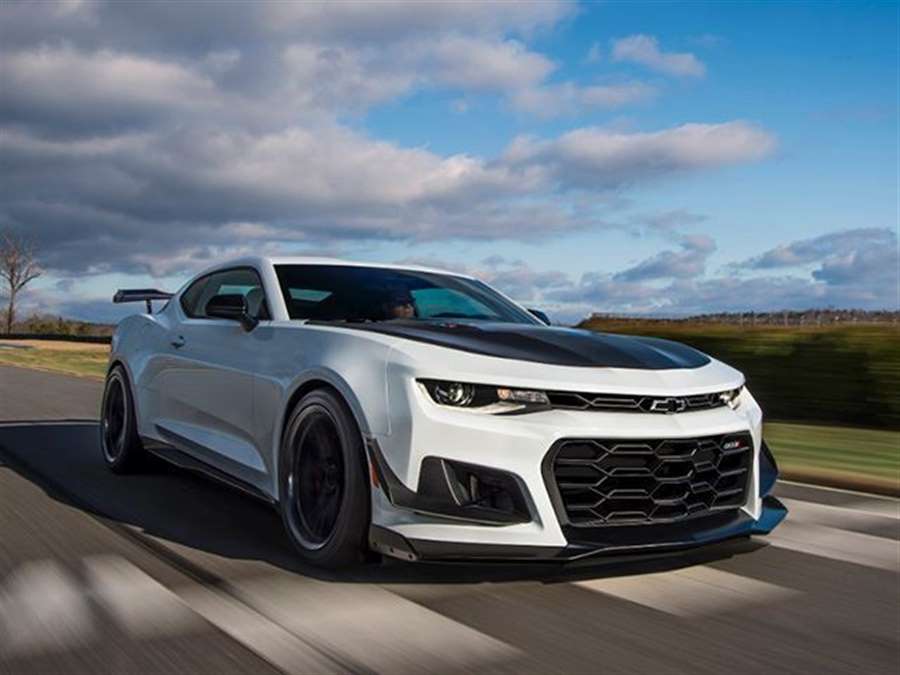
Namely, with the exception of copper present in the brake pads, it is badly considered and the abolition of certain types of tires is also not in line with waterways and salmon that swim on them. Because some of the tires use the antioxidant designation 6PPD-Quinone. And that bad antioxidant is responsible for the streams and rivers where it ends up during tire wear on a paved surface.
So now I'm just waiting to see the list of manufacturers and models of tires that kill salmon with their particles. And then I go to support the murder of a few more and buy a can containing at least part of it. Because it is as meaningless a reaction to this kind of news as the news itself is the meaninglessness of today's life on the road.
And it is only a matter of time before eco-mentalists in our region will realize that, for example, driving a Golf "deuce" poses a danger to the development of pulmonary alveoli on salamanders. Or that buying cheaper winter tires negatively affects the sex life of earthworms.
And then we are again followed by bans, regulations and penalties which, like the last jerks, will fill the state budget.
Wonderful, isn't it ?!
2022 Kia Carnival First Drive Review: So Long, Sedona
No Ferris wheels or fried dough, but the Carnival is good fun.
Drop the fantasy for a moment. As much as we'd all love to project the rough-and-tumble, outdoorsy ruggedness associated with the deep-voiced sales pitches in SUV ads, how often are you really tackling anything more challenging than a gravel parking lot or a dusty fire road?
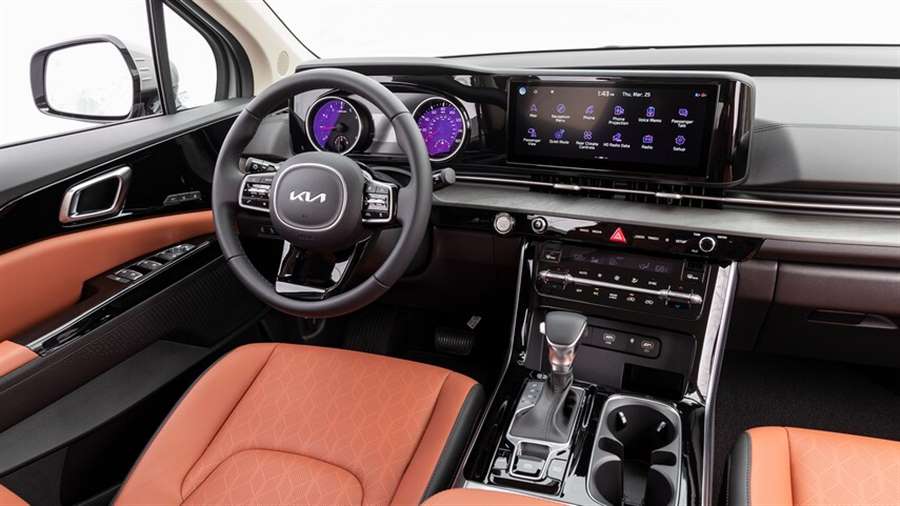
Buyers in need of three-row seating but who won't capitalize on the off-road Sporting aspect of a sport utility vehicle can get loads more utility out of a less ostentatious, less understood class of vehicle. The clever buyer shops for a minivan—or as Kia is calling it, a multipurpose vehicle (MPV). As much as we love the SUV of the year-winning Kia Telluride, the new 2022 Kia Carnival MPV could be a smarter fit for most families.
If you haven't heard of the Carnival, you're not alone. Kia introduced it as a new nameplate for 2022 to replace its Sedona minivan, which Kia has sold in the U.S. since the 2002 model year.
The Carnival rides on a lighter, stronger platform than the outgoing Sedona and features boxy, SUV-inspired sheetmetal reminiscent of newer Kia designs, including the Telluride, Seltos, and Sorento. (A neighbor even asked if it was an SUV or a minivan, which surely would thrill Kia's designers.) This is also the first model to don the newly redesigned Kia badge.
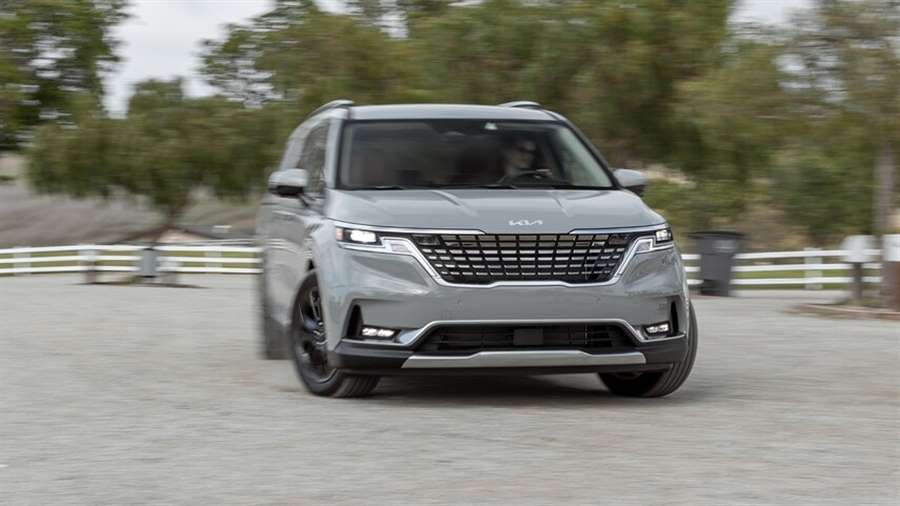
Cavernous Cargo Carrying
The Carnival is more spacious than the van it replaces, too. With 40.2 cubic feet of cargo space behind the third-row bench, it has 6.3 cubic feet more cargo volume than the old Sedona and at least 6.7 cubes more than any other current minivan. Stowing the third-row seats is easily doable with one hand via a chunky handle on the back of the seat, and with the seats folded, the load floor is completely flat.
Space behind the second row is class-competitive but a few cubes behind a comparable Honda Odyssey or Chrysler Pacifica. The Carnival's second-row seats are removable (in all models save the range-topping SX Prestige), a feature the Sedona didn't offer. To do so, lift a lever under the back side of the seat and fold the seat forward; removal requires no more than average adult strength, but the awkward shape means it may be wise to enlist the help of a partner.
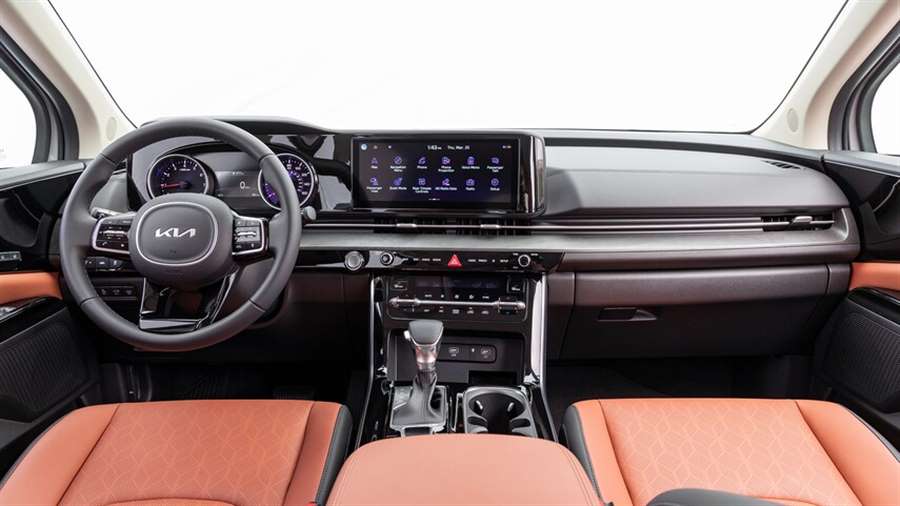
Those planning to frequently swap between using the maximum space behind the first row and using the second-row seats may be better off with Chrysler Pacifica's Stow 'n Go solution rather than wrangling the second-row seats into and out of the Carnival. Once they're removed, however, not only does the Kia have more space behind the first row than any other minivan, but its cargo volume also measures larger than that of the colossal Chevrolet Suburban (145.1 versus 144.7 cubic feet).
Three Roomy Rows Of Seating
But don't go thinking the Carnival is just a cargo van stand-in. The new MPV can be ordered in seven- and eight-passenger configurations, both with ample legroom in all three rows. Third-row access is near effortless with a one-hand pull of a handle beneath the second-row armrest that folds and slides the seat forward; older kids will have no problem operating it themselves. Third-row legroom matches the Pacifica and is a couple inches behind the Sienna and the Odyssey. A 6-foot-1 passenger has just enough legroom in the way back, but their head likely will be brushing the ceiling. Also, the rearmost windows border on claustrophobia-inducingly small.
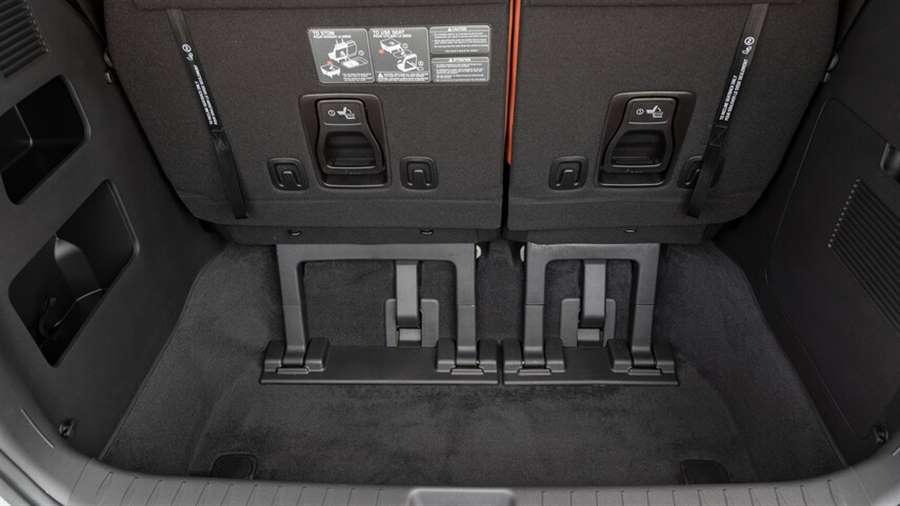
The second row is really where it's at. Beyond the 40.5 inches of legroom, its neat aspect comes with the SX Prestige and its "VIP" second-row seat. The Prestige swaps out the standard second-row bench for two leather-lined, heated, and cooled lounges that are more comfortable than the furniture in most living rooms. You can slide them way back, to make room for the Prestige's party trick: full recline with power-extendable legrests. Friends compared them to the plush recliners in upscale movie theaters. At $47,275, the Carnival SX Prestige is pricey, but it's less than other top-spec minivans. And it easily represents the most luxurious rear seating experience in any car under $50,000.
Up front, there's an 8.0-inch touchscreen infotainment system featuring Apple CarPlay and Android Auto as standard, but that's only on the base model. All other trims showcase a huge 12.3-inch display that's set high on the dash to keep your eyes near the road. Through the infotainment screen, the driver or front passenger can access the cabin camera and the intercom (standard on EX and above), which allow parents up front to talk to and keep an eye on kids in the back without turning around.
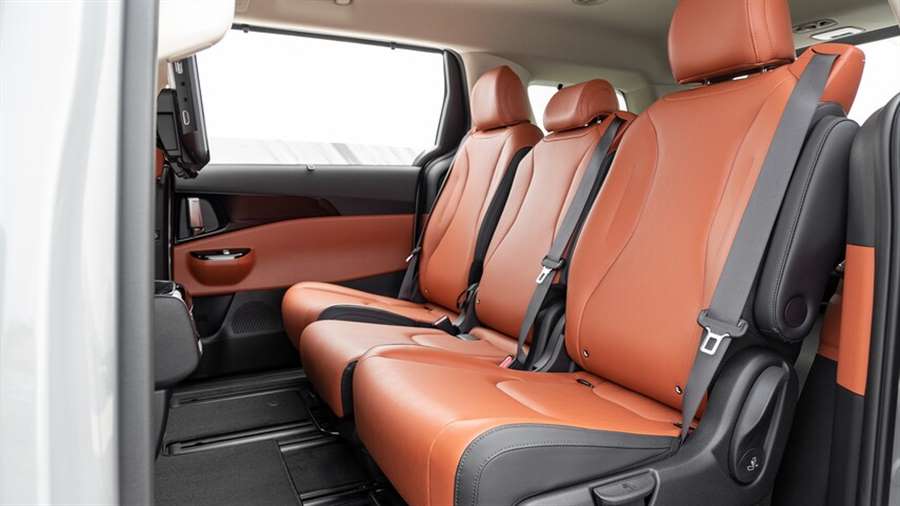
Living With The Kia Carnival
For the most part, it all comes together as a well-executed people mover.
There are six USB charging ports in the car (eight with the rear seat entertainment displays) plus two three-prong household outlets and two 12-volt power outlets. Including the wireless charging pad that's standard on EX trims and higher, it's possible to charge as many as 13 devices at once. The Carnival has 11 cupholders, too—no matter how many people you pack into this thing, no phone need go uncharged and no cup or juicebox unheld.
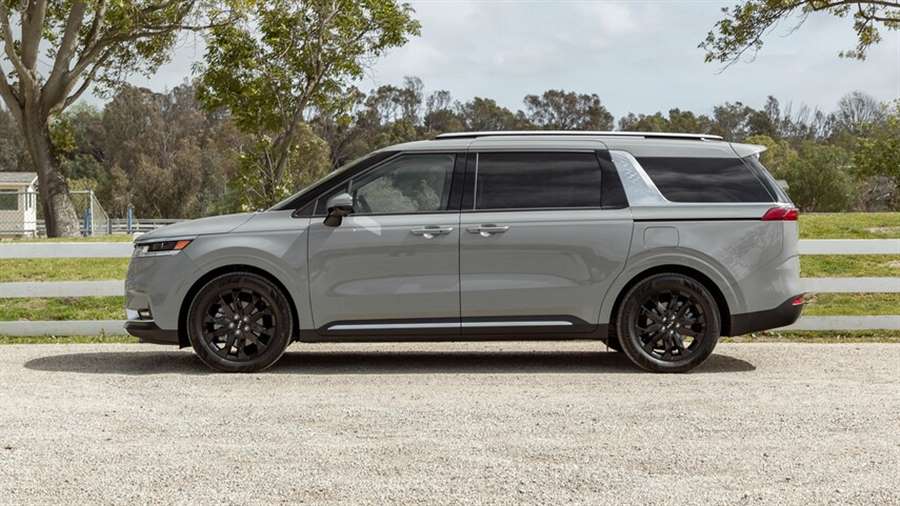
The interior design is just as handsome as the bodywork. Kia integrates metal-look trim throughout the cabin, and leatherette upholstery is standard on the EX and SX. Especially with the Prestige trim's dual 12.3-inch front displays, the cabin gives off real Mercedes-Benz vibes. That said, the metallic trim can cause dangerous glare for the driver in the wrong light. What's more, Kia's overreliance on capacitive-touch buttons for HVAC and infotainment controls can be frustrating, as they lack tactile feedback and can be tough to find without taking your eyes off the road.
SX trims and above include dual 10.1-inch displays as part of a rear entertainment system. The displays feature preinstalled apps for streaming Netflix, Youtube, and Twitch, and there's a kids mode with graphics by Pinkfong, the South Korean children's educational empire behind last year's Baby Shark phenomenon. Factor in the HDMI, USB, and wireless device-mirroring capabilities, and the entertainment prospects are vast.
The rear entertainment displays are not perfect, however. Streaming content through any of the preinstalled apps requires connecting the system to a paired smartphone's Wi-Fi hot spot because unlike its competitors, the Carnival does not include one. In an effort to treat the Carnival as a mobile office for an afternoon, we were also frustrated to find the HDMI input produced a fuzzy, low-res image and too much lag to accurately use a cursor, though Kia insists the examples we drove were pre-production units and this could change.
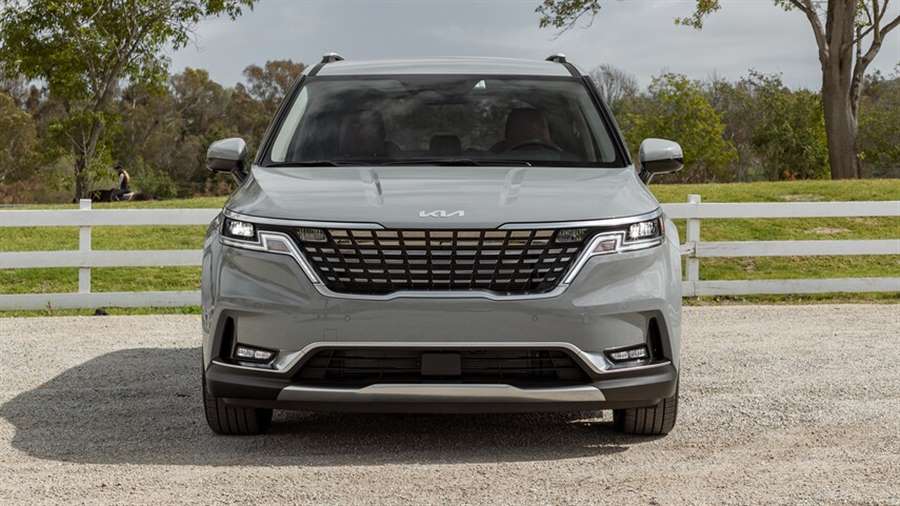
Kia Carnival Driving Impressions
The biggest surprise from our time with the Carnival? How well it drives.
Kia has developed a new 3.5-liter naturally aspirated V-6 for the Carnival. With 290 hp and 262 lb-ft, it's the most powerful engine in the segment and is tied for the most torque. Paired with a smooth-shifting eight-speed automatic that is rarely caught in the wrong gear, the engine provides ample acceleration. The Carnival is also rated to tow 3,500 pounds, which is typical for this class.
Vans like this need to ride well, too, and this Kia achieves that. The combination of relatively soft springs and tires with plenty of sidewall delivers a plushness that won't wake the baby in the back seat if you hit a pothole. More impressive, though, the Carnival exhibits next to no body roll and minimal secondary ride motions. It's genuinely fun to drive. And when you're just on a highway slog, Kia's lane centering and adaptive cruise control systems are among the best in the business.
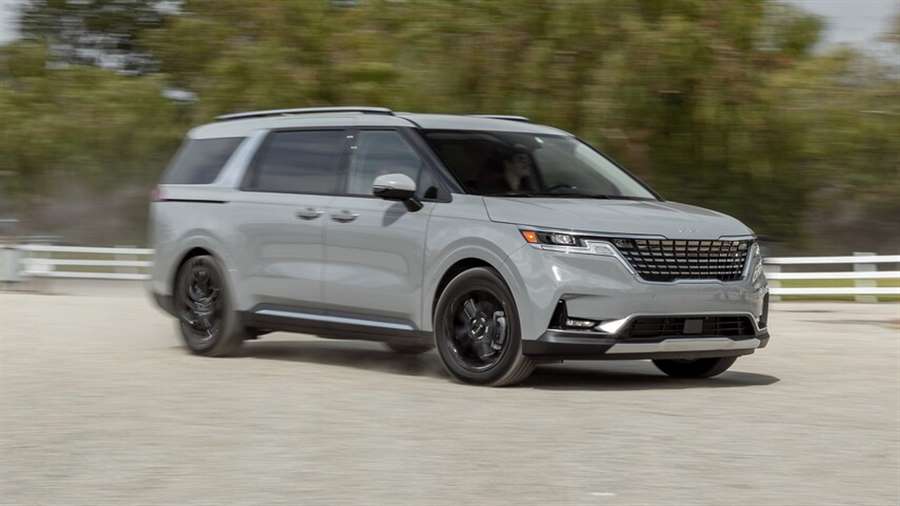
That Highway Driving Assist is part of a generous collection of driver assist active safety tech. Automatic emergency braking, pedestrian detection, lane centering, blind-spot monitoring, rear cross-traffic alert, driver attention warning, and rear occupant alert are all standard, even on the base model. The EX trim adds front parking sensors and Highway Driving Assist adaptive cruise control; the SX gains auto rear braking and an (invaluable) high-res 360-degree camera system; and the SX Prestige boasts a blind-spot camera feed in its 12.3-inch digital instrument cluster.
Our only complaint about the mechanicals is the lack of choice. With the new Sienna debuting with a hybrid-only powertrain and Chrysler offering a plug-in hybrid Pacifica, some buyers will be dismayed by the Carnival's 22 mpg combined fuel economy rating. (Queried about the lack of a hybrid offering for the Carnival, a Kia representative said, "Be on the lookout for what's in store. ") Drivers in colder climates may also be lured away by Chrysler and Toyota's available AWD—the Carnival is FWD only.
The Verdict
We mentioned earlier that Kia is marketing the Carnival as an MPV, a multipurpose vehicle. Nothing wrong with that; it can manage stand-in duty as a comfortable road tripper, an executive luxury limo, or even a full-blown cargo hauler.
But consider the Carnival's strengths: smooth ride; thoughtful, family-friendly features; intuitive tech; and a vast, high-quality cabin. Lean in to the stereotype, Kia. The Carnival is an excellent modern minivan.
New EU tire labels from 1 May
The EU tire label, introduced in November 2012 as a binding label, shows rolling resistance (fuel consumption factor), rain grip and noise, and the new one from May 2021 is clearer, more interactive and clearer…
Autoportal writes that tires, that is, tires, are the most important part of a car, because only with tires, with an area of four human palms, does a car touch the ground (road). This allows you to drive on the desired path and ensures handling, stability and braking of the car.
Driving tires create rolling resistance, which directly affects the car's driving characteristics and fuel consumption and noise, and at the same time wears out. It is a kind of necessary evil, because it creates negative work (mechanical losses), which worsens the car's performance and increases fuel consumption. The rolling resistance of the tire cannot be abolished, but it can be reduced.
Rolling resistance makes up 10 to 30 percent of driving resistance, depending on the speed and slope of the road, engages as much effective energy of the car engine and directly affects fuel consumption.
The smoother and harder the tire, the lower the rolling resistance, but also the worse the grip. Especially on wet and slippery roads. Traction in the rain, which creates slip resistance and shortens stopping distances, is extremely important for steering and driving safety.
The third feature of a car tire is noise when driving, because when the tire rolls, vibrations and sound waves, from the contact surface, are transmitted to the cabin and affect driving comfort. Tire noise has a detrimental effect on the environment, especially around highways. But it does not affect driving characteristics and safety.
In November 2012, EU legislation prescribed that every tire must have markings that show what characteristics car tires have according to these characteristics (rolling resistance, wet grip and noise).
Rolling resistance has so far been classified into seven categories (A, B, C, D, E, F, G) with the proviso that it has been divided into two areas, each with three gradations - good (A, B, C) and bad (E, F, G). D was an empty area, a kind of buffer zone. Noise was vividly described by sound waves - one, two and three, with quantification of the maximum noise intensity, by the number of decibels (dB).
The new EU mark, a binding label on every car tire, or classification, which comes into force on May 1, 2021, is more logical and clear. The grades of rolling resistance and grip on wet roads are divided into five categories, with A being the best. Categories A, C and E are marked with colors as on the traffic light - green, yellow, red, and B and D are intermediate colors - light green and orange.
According to the new, the noise level is marked with A, B and C, from the smallest to the largest. The new EU label also introduces a separate classification for snow tires (symbol of Triglav with a snowflake) and ice (spike with ice). Additional information on the tire label is the type designation, with the item number, adapted to the standard sales network.
The Spanish government subsidizes the purchase of electric vehicles
The Deputy Prime Minister of Spain and the Minister of Ecology, Teresa Ribera, stated that the Government will support the purchase of electric vehicles with 400 million euros.
This program, which can be increased to 800 million euros, will last until 2023, and it is also intended for individuals and companies. Part of the funds will also be used to install filling facilities, writes "La Vanguadria".
She says that for the purchase of passenger cars, you can get up to 7,000 euros for a car and 1,300 euros for the purchase of an electric motorcycle.
The novelty is that the program also subsidizes up to 9,000 euros for the purchase of an electric van.
Registration has started, and the goal is to have 250,000 electric vehicles and 100,000 charging places on Spanish roads by 2023.
"This will avoid 450,000 tons of carbon dioxide and create employment at a critical time for the economy," the minister said.

